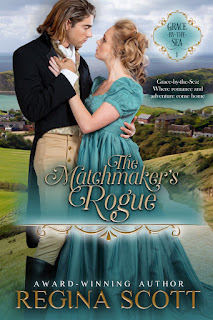Here’s another post in our
ongoing series on Regency fabrics.
As I have in previous posts, I’ll be examining actual fabric samples glued into
several earlier editions of Ackermann’s Repository, samples supplied by
the manufacturers and published by Ackermann in order to boost the British
cloth-making industry at a time when exporting British goods to Europe was
almost impossible because of the Napoleonic war. I'll give you a close-up scan
of each sample, the published description if available, and my own observations
of the color, weight, condition, and similarity to present-day materials, to
give you as close a picture as possible of what these fabrics are like.
Today’s three samples are from
the November 1812 issue of Ackermann’s Repository. The overall condition of my copy is excellent; the page
itself is free of foxing and is hardly toned. Two of the three samples show
some discoloration where they were glued to the page, but overall they’re in very good condition.
Here we go!
No. 1 and 2 is an entirely new article for white beds and other furniture,
which we have been favored with from the house of Millard in the city; it has a
beautiful effect in the piece, and produces a rich appearance when made up. This
handsome manufacture will be found desirable to persons who have large
establishments to furnish for, as it wants no lining, and is sold by the piece
at a very reasonable price; this and various other fashionable articles at
Millard’s, being disposed of on a liberal plan. We understand considerable
purchases of curious foreign articles have been made by this house at the late
great Custom-House sales.
My comments: Interesting fabric—alternating
stripes of plain weave and twill weave, with an overall jacquard botanical
pattern overlying the stripes. An intermediate weight cotton (my guess), with a
light glazing like chintz. It would definitely make handsome window draperies or bed curtains.
No. 3 is a specimen of a new and beautiful manufacture for ladies’ winter
dresses, from the above house, where it may be obtained in any quantity, and of
various colours. It does not exceed mediocrity in price, although it possesses
the useful property of never creasing in the wear; added to which, it resembles
the genuine China crape, by its falling naturally into the most graceful folds.
My comments: Another interesting fabric,
and not just because it’s orange with black polka-dots. 😀 I’m trying to figure
out the fiber content: wool/silk maybe? It definitely has a crepe-like texture,
twill-woven with slightly uneven threads. I can see that it would drape well;
it’s also opaque, though for a winter dress a lining would be preferred.
No. 4 is a pattern of a chaste and elegantly figured sarsnet silk, for
a lady’s evening dress. It is of a most pleasing colour, of neat fabric, and of
a very delicate texture. It is sold by Messrs. George and Bradley, the Golden
Key, Holy-well-street, Strand.
My comments: I’ll have to agree with Mr.
Ackermann’s assessment of this “article” as being elegant and delicate. Finely
woven silk in a handsome diamond pattern, of a pale mauve-ish pink—it’s
difficult to tell if there has been any fading or other color alteration over
the centuries. Curiously, the scan doesn't show that the diamonds are actually of white satin-stitch weave with pink centers. Because of its delicacy, it would probably need to have been
worn over a slip. Lovely!
What do you think of this
month’s fabrics?
 We’ve talked about the center of London shopping in the
early nineteenth century before, for example here and here. Bond Street called
to young ladies and gentlemen, offering the latest and finest in everything
from clothing to housewares and literature. It was also the home of Gentleman
Jackson’s boxing emporium and Angelo’s fencing school. But recently I became
aware that Bond Street also featured any number eateries, and some of their
wares sound downright yummy.
We’ve talked about the center of London shopping in the
early nineteenth century before, for example here and here. Bond Street called
to young ladies and gentlemen, offering the latest and finest in everything
from clothing to housewares and literature. It was also the home of Gentleman
Jackson’s boxing emporium and Angelo’s fencing school. But recently I became
aware that Bond Street also featured any number eateries, and some of their
wares sound downright yummy.


















